
Previous page...
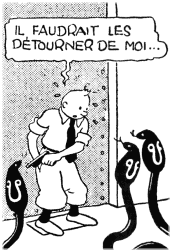 Transformations
Transformations
The interesting aspects in the black and white editions are multiple since, in most cases, the stories underwent several transformations. During the redrawing, Hergé faced several difficulties. Most difficult was undoubtedly the new page setting. In a very general way, he reduced the format of the frames and added a strip, roughly cutting the number of pages by half. Nevertheless, he had to delete or shorten some superfluous sequences, what enabled him at the same time to give more density to its stories. Thus a scene opposing Tintin to snakes in the traffickers' den in Cigars of the Pharaoh, a fight with a gangster at the end of The Blue Lotus and an arumbaya nightmare at the beginning of The Broken Ear disappear, inter alia. On the opposite, Hergé found that The Crab with the Golden Claws' story was too short, so he had to keep the old inset plates of the black and white edition, what explains the presence of the single giant frames in this book.
Hergé also proceeded to several technical improvements, erasing here and there awkwardnesses which had slipped into the stories : an answer which one could read before the question; rises which, in the direction of the reading, seemed to descend etc. All that undermined legibility - which had then become a great priority for Hergé - was worked on again. In the same way, to improve realism, several details were corrected. With the assistance of E. P. Jacobs, the syldavian costumes were entirely "balkanized". Finally, some more or less awkward dialogues were purified. Whereas the drawing became more and more complex, the texts became simpler.
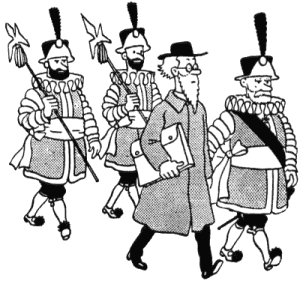
Finally, Hergé modified the historical and political dimensions of the first adventures. Any marked allusion to Belgium, any element too dated was removed. This cleaning was accompanied by a softening of the vocabulary and a greater tolerance. In this manner, the books were purified of what connected them too much to the context of their birth. By adapting them to the more recent books, Hergé ensured the coherence of its universe.
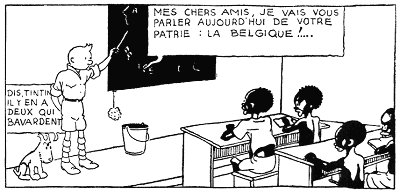
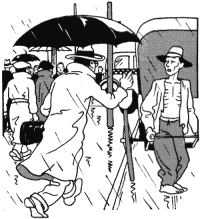 Undeniable qualities
Undeniable qualities
If the books in black and white have neither the technical quality nor the extraordinary coherence of the later editions, they are not for all that unimportant works. On the contrary, Hergé develops in them a complete graphic technique which one cannot compare with that of the new editions. Just like the cinema in black and white has its own esthetics, the books in black and white have a style of their own which gives them all their charm.
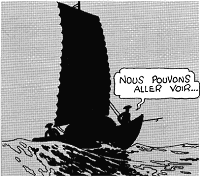 The medium has certain constraints, so Hergé tries not so much to show the things with realism than to suggest them. The drawing is extremely purified and simplified, the accessory is left to show only the essence. It is without any doubt in The Blue Lotus that this art is most developed, mainly thanks to the influence of Chang. Nothing comes to distract the reader. The sceneries are surprisingly simple, and yet everything suggests China. In the scene of Tintin's nightly boarding, only the junk's silhouette appears to suggest its presence, but with what a force! This simplicity, this accuracy and this elegance of the stroke give an very different dimension to the adventures of our hero...
The medium has certain constraints, so Hergé tries not so much to show the things with realism than to suggest them. The drawing is extremely purified and simplified, the accessory is left to show only the essence. It is without any doubt in The Blue Lotus that this art is most developed, mainly thanks to the influence of Chang. Nothing comes to distract the reader. The sceneries are surprisingly simple, and yet everything suggests China. In the scene of Tintin's nightly boarding, only the junk's silhouette appears to suggest its presence, but with what a force! This simplicity, this accuracy and this elegance of the stroke give an very different dimension to the adventures of our hero...
A forgotten adventure...
In addition to the editions mentioned previously, another adventure was initially created in black and white, without however being published in book in this form. Land of Black Gold was supposed to follow King Ottokar's Sceptre. However, its publication in the pages of Petit Vingtième was stopped in May 1940 by the invasion of Belgium by the German troops. Since the story was too politicized, Hergé had to give up it. After the war, he took it again from the beginning, in color. The 56 pages of pre-war period were never published. Here is one of them...
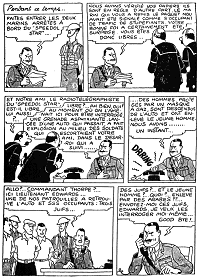
Facsimiles of the Soviets and the eight editions in black and white are available and published by Casterman. There is also a "Tintin en noir et blanc" box containing the nine books in miniature format.


